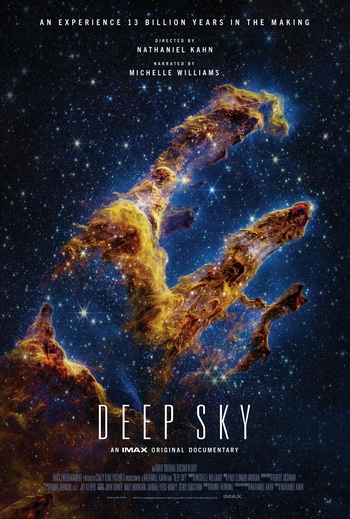 |
Review: Deep Sky
by Jeff Foust
Monday, October 30, 2023
Deep Sky
directed by Nathaniel Kahn
IMAX, 2023
40 minutes, unrated
It was inevitable, perhaps, that a very big space telescope would end up on a very big screen. Once it was clear that the James Webb Space Telescope was both a technical and scientific success, putting its dramatic images on an IMAX screen was something close to a no-brainer. “It has to be on an IMAX screen because only that giant screen is making you fully immersed in these worlds,” said Nathaniel Kahn at a National Academies event in July.
He would know since is the director of that IMAX movie about JWST, Deep Sky. The documentary, the latest in a four-decade-old line of such films produced in cooperation with NASA, offers a condensed history of the development, launch, and commissioning of the telescope, but really shines when it’s time to show off the images that telescope can produce.
| There is a much greater emphasis on what JWST has produced, including both the first science images as well as subsequent observations. |
Deep Sky is not the first documentary about JWST: Netflix released one, Unknown: Cosmic Time Machine, this summer (see “Review: Unknown: Cosmic Time Machine”, The Space Review, July 31, 2023). The Netflix document spent much of its one-hour running time focusing on the challenges building the telescope, including its major cost and schedule overruns, and going behind the scenes during the launch and commissioning of JWST. The payoff—those first science images—comes towards the end.
Deep Sky shifts that balance towards the science. The difficulties developing JWST are mentioned but not in great detail in narration provided by actress Michelle Williams, instead moving ahead briskly to the launch—another spectacle well-suited to the IMAX screen—as well as commissioning. There is a much greater emphasis on what JWST has produced, including both the first science images as well as subsequent observations. Astronomers included in the film explain, with the help of both JWST images and computer graphics, how JWST observations can address key topics from the early universe to looking for potentially habitable exoplanets.
That difference is not unexpected. Talking heads and behind-the-scenes visits to NASA Headquarters work well for a documentary that might be watched on a home TV or even a tablet or phone, but people paying a premium to watch a relatively short film on an IMAX screen want to be dazzled. In that respect, Deep Sky does not disappoint. Even if the medium is not the message, it at least helps craft it.
One challenge with a film like Deep Sky is that it runs the risk of being outdated relatively quickly as more images and more science results come in from JWST. At a screening earlier this month at the National Air and Space Museum’s Udvar-Hazy Center, film executives said they worked to add new images up to the deadline, getting the last one—which features a galaxy merger that looks like a question mark—a few days before the film was completed. But being outdated in that manner is not a bad problem to have.
Note: we are using a new commenting system, which may require you to create a new account.
No comments:
Post a Comment